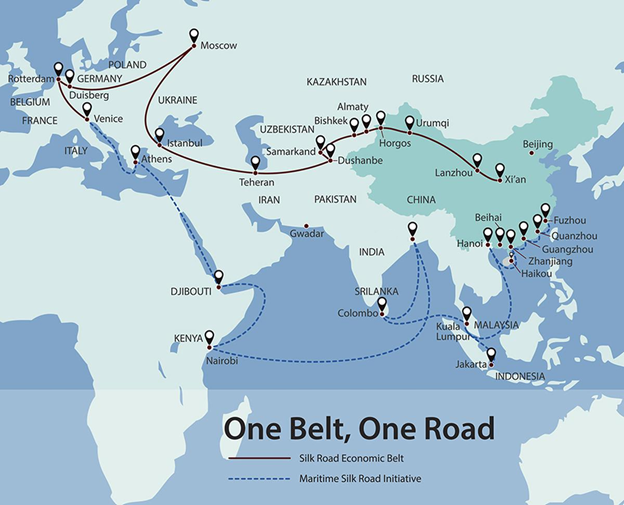The BRI at 10, some hits, many misses.
Relevance
- GS Paper 2 Groupings & Agreements Involving India and/or Affecting India’s Interests, Bilateral Groupings & Agreements.
- GS Paper 3 Infrastructure.
- Tags: #BRI, #CPEC, #India-Middle East-Europe Corridor (IMEC), #Indo-Pacific region.
Why in the news?
It’s the 10th anniversary of China’s ambitious Belt and Road Initiative (BRI). This colossal project, in 2013, aims to reshape global trade and infrastructure development.
Belt and Road Initiative
- The BRI, represents a multifaceted development strategy aimed at enhancing global connectivity and cooperation.
- It was launched in 2013 and aims to link Southeast Asia, Central Asia, the Gulf region, Africa and Europe with a network of land and sea routes.
- The project was first named the ‘One Belt, One Road’ but renamed as the BRI to convey a more open and inclusive initiative as opposed to a Chinese-dominated one.
- The initiative includes two principal components: the Silk Road Economic Belt and the Maritime Silk Road.
Routes of BRI
Silk Road Economic Belt
- This segment of the BRI is dedicated to improving connectivity, infrastructure, and trade links across Eurasia through a network of overland transportation routes.
Maritime Silk Road
- This component emphasizes maritime connections and cooperation in the form of ports, shipping routes, and maritime infrastructure projects.
- It begins via the South China Sea going towards Indo-China, South-East Asia and then around the Indian Ocean thus reaching Africa and Europe.
Objective
- The primary goal of the BRI is to boost international connectivity by enhancing infrastructure, trade, and economic cooperation.
- The initiative encompasses a wide range of projects, including railways, ports, highways, and energy infrastructure.
Geographic Corridors
The land-based Silk Road Economic Belt envisions six key corridors for development:
- China-Pakistan Economic Corridor (CPEC).
- New Eurasian Land Bridge Economic Corridor.
- China-Indochina Peninsula Economic Corridor.
- China-Mongolia-Russia Economic Corridor.
- China-Central Asia-West Asia Economic Corridor.
- China-Myanmar Economic Corridor.
-
-
Some More facts about BRI
- Initially BRI included the Bangladesh-China-India-Myanmar (BCIM) Economic Corridor. Later India refrained from joining the BRI, voicing its opposition to the CPEC that runs from Xinjiang in China’s west, through Pakistan-occupied Kashmir (PoK), to the Arabian Sea port of Gwadar.
- With India staying out, the BCIM corridor has also stalled, and has been replaced by a later launched China-Myanmar Economic Corridor.
Economic Impact
- Countries participating in the BRI have witnessed growth in trade and investments with China, leading to preferential treatment and policy benefits.
- Trade with BRI partners registered an annual growth rate of 6.4%, reaching USD 19.1 trillion between 2013 and 2022.
Issues Concerned with the BRI
Debt Burden
- The debt sustainability and transparency of the BRI projects, especially in countries with weak governance, high corruption, and low credit ratings.
- Some critics have accused China of engaging in “debt-trap diplomacy” by lending money to countries such as Sri Lanka and Zambia that ultimately find themselves unable to repay and then seizing their strategic assets or extracting political concessions in return.
Multilateral Governance
- The BRI is not a multilateral initiative but rather a collection of mostly bilateral projects. This decentralized approach can lead to coordination and governance challenges.
- Unlike initiatives like the Asian Infrastructure Investment Bank (AIIB), the BRI lacks a centralized governing structure, making it difficult to address issues collectively.
Political Tensions
- Geopolitical rivalries and disputes, such as the India-China border dispute, have affected the implementation of BRI projects in certain regions. These political tensions can undermine the initiative’s progress.
Environmental and Social Concerns
- Infrastructure development projects under the BRI have faced criticism for their potential environmental and social impacts. Ensuring that BRI projects are environmentally sustainable and consider the well-being of local communities is a challenge.
Geostrategic Concerns
- The BRI has raised geopolitical concerns, particularly regarding China’s growing influence and control over critical infrastructure in partner countries. These concerns have led some countries to reevaluate their participation in the initiative.
Global alternatives
- Indo-Pacific region.
- Build Back Better World (B3W) initiative.
Conclusion
- The G-20 Delhi summit posited yet another alternative in the form of the India-Middle East-Europe Corridor (IMEC) that seeks to link India, West Asia, and Europe through railways and shipping lines.
- In addition to the trade connectivity, electricity and digital infrastructure as well as a pipeline for clean hydrogen export have been envisioned. It is too early to assess the alternatives, but all eyes will be on the future of BRI as it completes a decade.
- At a time when Beijing is grappling with economic worries related to debt and unemployment, it remains to be seen how it will reinvigorate the “project of the century”.
Source: The Hindu
Mains Question
The China-Pakistan Economic Corridor (CPEC) is viewed as a cardinal subset of China’s larger ‘One Belt One Road’ initiative. Give a brief description of CPEC and enumerate the reasons why India has distanced itself from the same.




